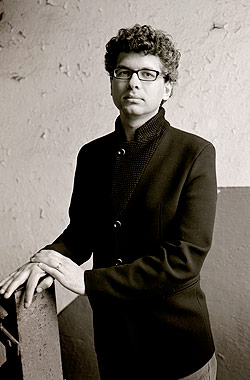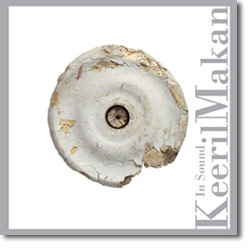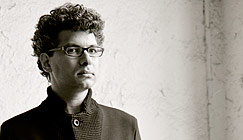 |  | 
Visceral Music [2009-03-03]'Visceral’ is a term often used in reviews of Keeril Makan’s Tzadik release In Sound (2008). Indeed, the music from this young American composer seems to come from a deep source inside, and covers many different styles and emotions, while at the same time sounding fresh and original. An e-mail conversation resulted in the interview below, in which I asked the composer about his other work, inspiration and future recordings.  Keeril Makan's debut CD, In Sound (Tzadik) was released in June 2008 containing three of his compositions. The release stood out from much of the current output of the label, sounding fresh, modern, traditional and original at the same time. In Sound deserves more attention than it has received, not only because of great performances (Kronos Quartet at their best), but also because the recording quality is fabulous and makes enjoying the timbral richness of the music easy. Makan’s biography mentions he was trained as a violinist and received degrees in music and religion from Oberlin and the University of California, Berkeley. Makan also studied in Europe and has had works commissioned by the Bang on a Can All-Stars and Kronos Quartet. He is Assistant Professor of Music at MIT and makes his home in Cambridge, Massachusetts. Currently, he is living and working in Rome, after receiving the Rome Prize from the American Academy in Rome for 2008-9. His website mentions a list of works that aren’t all available yet on CD, but more recordings are on the way. Keeril Makan's debut CD, In Sound (Tzadik) was released in June 2008 containing three of his compositions. The release stood out from much of the current output of the label, sounding fresh, modern, traditional and original at the same time. In Sound deserves more attention than it has received, not only because of great performances (Kronos Quartet at their best), but also because the recording quality is fabulous and makes enjoying the timbral richness of the music easy. Makan’s biography mentions he was trained as a violinist and received degrees in music and religion from Oberlin and the University of California, Berkeley. Makan also studied in Europe and has had works commissioned by the Bang on a Can All-Stars and Kronos Quartet. He is Assistant Professor of Music at MIT and makes his home in Cambridge, Massachusetts. Currently, he is living and working in Rome, after receiving the Rome Prize from the American Academy in Rome for 2008-9. His website mentions a list of works that aren’t all available yet on CD, but more recordings are on the way.
It was my strong reaction to the music that led me to contact Makan. In the liner notes of In Sound, Makan states that he writes music he wants to hear. He also describes the process that led to the music on the release, but seems only to scratch the surface. There is a huge difference between the first and last pieces on the CD: The Noise Between Thoughts is as aggressive and noisy as a string quartet can be, but melody and a placid, reflective mood characterize Washed by Fire, the biggest surprise here. But what’s important to realize is that labels liner notes don’t do justice to the music and fall short in describing what lies beneath it. There is a visceral quality present in all three works on the release: in this interview, Makan explains what this visceral quality is and where it comes from.
m[m] Your website lists quite a number of pieces with varying instrumentations. Could you explain how these came to be, and how your previous music differs from your current work?
Makan About 10 years ago while I was still a student, I decided to try to use the simplest musical materials (in terms of pitch) and simplest musical processes (in terms of rhythm) that I could. By working with severely reduced material I found that the musical discourse became focused on playing with the listener's expectations, particularly in terms of continuity and discontinuity. Cut for string quartet (1997) and 2 for violin and percussion (1998) are the best examples. I worked with sequencers to model what I was writing, and in some cases composed directly at the computer. By experiencing the music in real-time through computer playback I was able to make much bolder formal experiments than when composing with paper and pencil.
Part of my motivation to simplify and concentrate on audible musical processes arose from a desire to reconcile the multiple musical influences in my life. In addition to classical and contemporary music, I grew up with Indian classical, the blues, rock, folk, and world music. By simplifying the surface of my music, I hoped to find the properties that were held in common among all of my influences. I began to realize that what made my voice distinctive was a uniquely visceral energy.
At about this time, I had the opportunity to live outside of the U.S., first in Helsinki from 2000-2001 and then later in Paris from 2002-2004. I was already familiar with most of the important European contemporary composers, and although I wasn't having any revelations at concerts, being in Europe gave me license to push my boundaries further. I had become thoroughly frustrated with sequencers because I had no access to timbre: the software only allowed me to play with pitch and rhythm.
To be able to compose with timbre, I returned to the violin. I played quite a bit when I was growing up, but burnt out and quit when I went to college in 1990. In relearning the instrument, I approached it with as much naïveté as I could, exploring what it meant to put horsehair to string. In addition, I found that I could take this naïve approach to other instruments, and learn them without being concerned about the Western tradition. First I wrote a short string quartet called, Tear (2001) and then a solo cello piece, Zones d'accord (2002). On the Tzadik release, Threads (2002) and The Noise Between Thoughts (2003) come out of this period.
m[m] Threads is quite different from the other two compositions on the Tzadik release, making use of electronic as well as acoustic sounds. How did this piece come into being?
Makan In the case of Threads I had an electric guitar and bass clarinet to work with, in addition to my violin and three samplers. The electric guitar is bowed throughout; however, the sound is made either by threading a wire through the strings and bowing the wire, or tying fishing line to the strings and bowing the fishing line. It allows for more control than just bowing the guitar strings directly.
In these works, I was still composing at the computer, but I recorded myself playing and multi-tracking it. I had a modelling environment similar to the sequencers, but this let me focus on timbre, in the same concentrated way that I had earlier focused on simple materials. Again, my influences came to the fore, particularly Lachenmann, Sciarrino, Grisey and Scelsi. To me, there wasn't a big difference between these two styles because the energy was the same. The surface had changed, but the intensity of expression hadn't.
One influence that has always been with me is the music of Morton Feldman. It may be difficult to hear because people think of his music only in terms of its surface. But I find it fascinating to hear how his musical mind gets laid out in front of us: we hear how he thinks. We are forced into a radical confrontation with each moment in time. At this particular moment, what are you going to do? The question of expectation, of continuity and discontinuity, comes into the foreground as the central question of experience.
The visceral quality of a lot of my music reflects the moment of composition. Getting myself into a state where I feel that I am experiencing time with an awareness of my whole being. In a piece like The Noise Between Thoughts or Voice within Voice (2005) for baritone saxophone (which is available on the Innova label) that state was most accessible to me through a relatively brutal physicality. Though exhilarating, it also could be debilitating, because I was afraid to enter such a violent place so frequently.
In the past year I have started practicing a form of Buddhist meditation (Vipassana), but my music seems to have predicted this interest. The first piece that took me to a different space than the violent space I had been in was a concerto for violin and viola entitled Still (2006). There are three things at work: a return to the desire 1) to make music with simple materials; 2) to create timbres and material that come from my experience of playing instruments; and 3) to focus on making music from a place of simplicity. Everything comes from a wish to strip away the inessential and to trust my body and my experience of time. Still was written before I began meditating, as was Washed by Fire (2007). This string quartet was for dance, and in the process of collaborating the choreographer and I decided to try to create materials that we liked, but would ordinarily be ashamed of and wouldn't want other people to know about. I took this to heart since it was in keeping with my desire to trust my experience. I started writing music that was unlike the more timbrally focused pieces I had been writing since 2001. I wrote modal melodies, and rhythmic gestures that I hadn't done since 2001. I used the computer both as a recording device, and as a sequencer, so both approaches to musical modelling were used. After completing Washed by Fire I started my meditation practice. It is unclear to me how it will effect what I do.
 m[m] How difficult is it for you to have your work performed live? Is the cultural climate for new classical music in Europe different compared to the U.S.? m[m] How difficult is it for you to have your work performed live? Is the cultural climate for new classical music in Europe different compared to the U.S.?
Makan This CD has put me in a somewhat strange position. The first piece, The Noise Between Thoughts, has only been performed by Kronos once. They premiered it in Paris in 2003, and have never played it again. It has just been performed this year in Berlin by the Sonar Quartett, and in Helsinki at the Musica Nova Festival with musicians from the Finnish Radio Symphony Orchestra. It still awaits a U.S. premiere. Threads will probably never be performed again after its initial two performances because the instrumentation is so strange. In any case, the CD actually sounds better than the piece does live because I had a lot more control of the electronics in the studio. Balancing the acoustic and electro-acoustic elements in a concert hall is difficult. Washed by Fire is the most frustrating. It has never been performed live! I have a great recording of it, but there has yet to be a premiere. LEVYdance has danced to the recording a number of times, but it's not the same, obviously, as a quartet performance. If there are any quartets out there looking to premiere it, let me know!
I've lived for half a year in London, one year in Helsinki, two years in Paris, and now a year in Rome. I will get some flak for saying this, but the European new music scene is better than the U.S. in every way. Classical music is part of the European cultural heritage. It is supported, encouraged, debated, and generally considered of value. In the U.S. we have some great performers of new music, which is our main saviour. We also have groups like Kronos, Bang on a Can and the Reich Ensemble, which tour and bring a certain type of music to a larger audience. But in general, the situation in the States is pretty dire. There is essentially no governmental support of the arts. We rely upon foundations and individual patrons. There just isn't the money to rehearse pieces properly, unless they're for small ensembles. As a result, it changes the way people compose. In addition, music is vanishing from children's education. You can't assume any knowledge base in an audience, and this will get worse as time goes by.
The main problem that I've seen in Europe is that power is oftentimes concentrated in the hands of a few people. As a result, institutional styles of music seem to emerge. Every once in a while a composer will come along that smashes the established norms, like Grisey or Andriessen. But then they become the new model.
m[m] How were the reactions to the release of In Sound?
Makan There have been some reviews and lots of personal feedback. The Noise Between Thoughts is certainly the piece that has been hardest for most people, given its aggressive and noisy sonic world. Washed by Fire, however, counterbalances it. It has been difficult for some people to appreciate all three pieces on the CD, because the surfaces are so different. To me, the motivations behind the pieces are all connected.’
m[m] Will the collaboration between you and Tzadik continue in the future?
Makan I think there will eventually be a second CD on Tzadik, but not for a few years. It is important to Tzadik that the second CD be as good or better than the first; they also want it to feature ensemble pieces like the first, so it will take some time and money to make this a reality. I have just finished a recording session with the New York ensemble Either/Or. There are three pieces: 2 (1998) for violin and percussion, Zones d'accord (2002) for cello, and Resonance Alloy (2007) for percussion. All three pieces show my concern with sound and time. I'm very excited by the last piece, a 30-minute work for 3 cymbals and gong exquisitely performed by David Shively. We are looking for a label now, so hopefully it won't be too long before it gets released.
See Makan's website for a biography, discography, events, and list of works with sound samples.
|
|
 |
 |
 |

|  | | Visceral Music | 'Visceral’ is a term often used in reviews of Keeril Makan’s Tzadik release In Sound (2008). Indeed, the music from this young American composer seems to...
 |  |
|
|
|
|
|

 |

|  | | Young Blondes, Stalked and Murder... | Young Blondes, Stalked and Murdered is a 2024 film that blends elements of character study, slasher/serial killer thriller, and trying to make it in Hollywoo...
 |  |
|
|
|
|
|
|
 |

